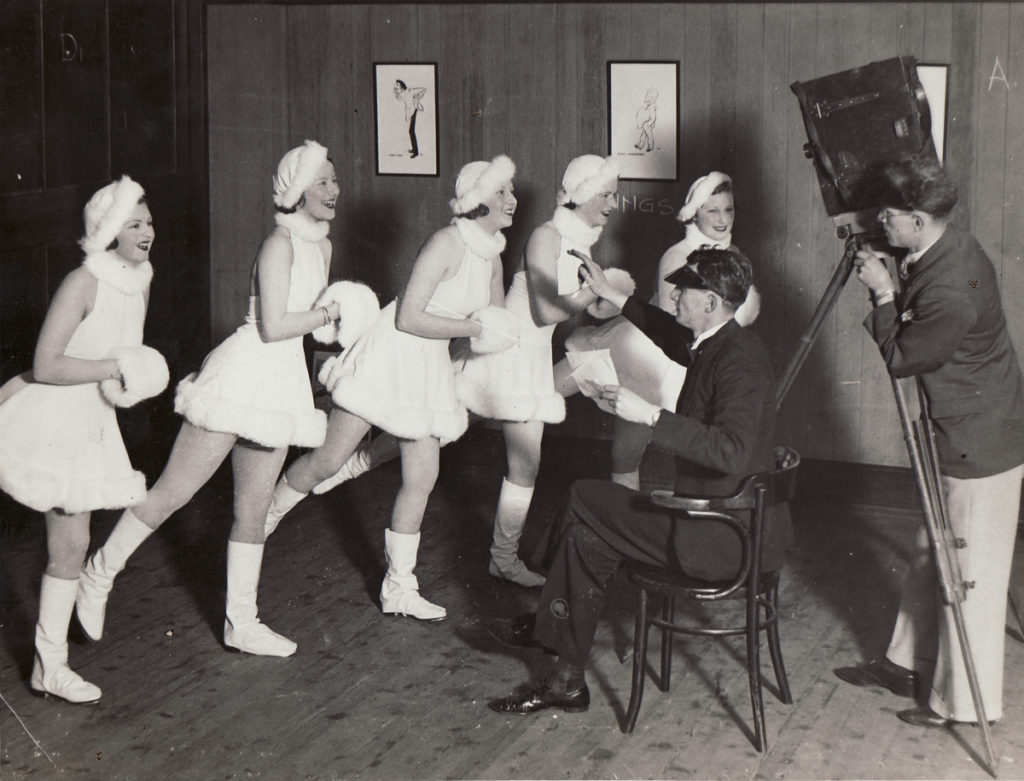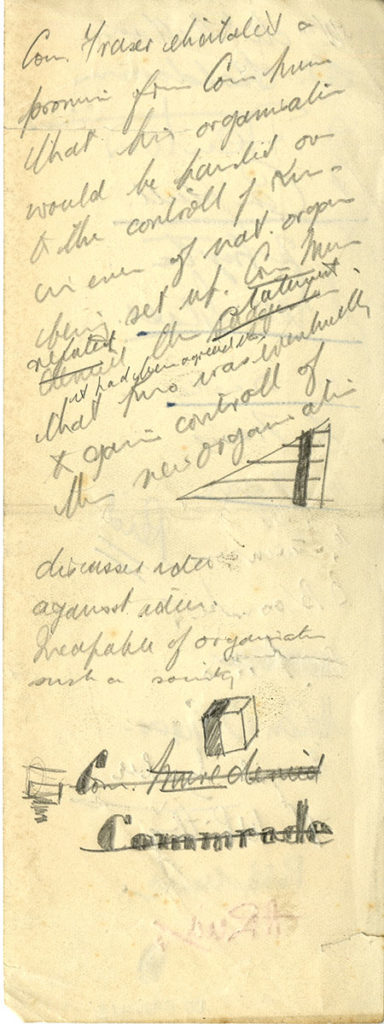Following on from Part One in a blog series about Helen Biggar’s early GSA career, SGSAH PhD intern Molly McCracken tells us about Biggar’s subsequent success as a filmmaker, in collaboration with Norman McLaren.
In 1936, Helen Biggar and Norman McLaren released Hell Unltd, an anti-war film whose credits address it to ‘all who are made to pay each day for their own and other people’s destruction, to all who are taxed just now to pay for the future murder of millions of men, women and children, and especially to those who sit back and say “we can do nothing about” [it]’. As the students received no grants from The GSA, they had to self-fund the production, often relying on events like dances to raise money. The film was screened at The GSA, though Biggar’s decision to invite press to the screenings – indicative of her precociousness – caused consternation from the Secretary, who was concerned about the display of propaganda in a public institution, suggesting future screenings should be limited to the student body and filmmakers (GSAA/SEC/23/9/6).

Controversy aside, the film was highly regarded by critics and viewers. The Scotsman’s review celebrates Biggar and McLaren’s bravery in tackling such serious themes: their ‘youthful lack of restraint may be largely forgiven in a film of spirit and substance’. Interest in the film spread as far as the United States, where an article in New Theatre expressed demand for a screening of Hell Unltd in New York, ‘where its message is as urgently needed as in Great Britain’.
The film was screened at the Scottish Amateur Film Festival (SAFF) in 1937, where it was reviewed in the Aberdeen Press and Journal as ‘by far the most serious contribution to [the] festival since its beginning’. In SAFF adjudicator and film director Anthony Asquith’s notes, Hell Unltd is described as showing a ‘great deal of ingenuity and imagination’ with ‘nice touches of grim humour’, being deemed altogether an ‘effective piece of propaganda’. The film was awarded a prize of £10, which, recognising the disparity with which McLaren’s reputation as a filmmaker was developing ahead of Biggar’s, McLaren told her to keep as recognition of her work.

During the period in which Hell Unltd grew its audience, Biggar maintained ties to GSA, writing for student publications such as Vista, screening films to students, and continuing to collaborate with William Maclean. From the winter of 1936 she was increasingly occupied with her new involvement with Glasgow’s Kino Film Group, a politically-influenced organisation that screened anti-war and socialist films across the city, and regularly fundraised on behalf of anti-war causes. Part of the Group’s success was their use of the 16mm format, enabling films to be projected at a larger variety of venues compared to the more flammable and thus regulated 35mm format. As a series of press clippings held in Biggar’s archive attest, audiences reached as large as 900 people, with large sums of money raised for casualties of the Spanish Civil War (DC 097/4/1).
Despite her success, in letters to McLaren, Biggar describes disappointment at her inability to work on her own filmmaking and her sculptures, in part due to her busy schedule, but likewise her difficulties travelling – the result of two serious accidents in her childhood, which had left her with a reduced stature and physical weakness. One unfinished project was a film about Scotland’s history titled Death of a Nation; papers of Biggar’s held in GSA Archives and Collections headed ‘The Highland Clearances’ suggest perhaps an early attempt to storyboard the film, featuring descriptions of Scotland’s exploitation by England (DC 097/1/30).
Undeterred by these setbacks, Biggar continued to advance the Kino Film Group’s audiences across Scotland. As part of the Group, she produced a film about the 1938 May Day March in Glasgow titled Challenge to Fascism. Working again with GSA teacher Maclean, her film offered a counter to the state-sponsored films made for the coinciding Empire Exhibition at Bellahouston Park. Early preparations for the film are discussed in the Kino Film Group’s minute book (DC 097/4/2); placing adverts seeking donations to support the film’s production in the Scottish Co-operator, Biggar’s project offers an early example of crowd-sourcing in the arts, allowing her relative freedom in the production of the film.
By 1940 Biggar still remained involved with GSA staff and students – befriending, for example, refugee students Josef Herman and Jankel Andler; throughout the decade, however, her engagement with the School declined. She found new projects as part of the Worker’s Theatre Group (WTG), and in 1944 a commission to create costumes for 500 performers on behalf of the Cooperative Society of Glasgow returned her to her roots in textile design. Increasingly engaged with the theatre, she helped to produce and tour The Gorbals Story, a play dramatizing working class life in Glasgow, even playing in London’s West End. In 1947, the WTG was one of the original companies that unofficially performed in Edinburgh alongside the International Festival, ostensibly beginning what is now the Fringe Festival.
Though her work with the WTG continued Biggar’s life-long political engagement, over time she struggled to commit her full energy to the project. As Shepherd describes, Biggar often worked excessively to challenge perceptions of her frailty. Nonetheless, Biggar’s biography attests to her rapacious energy and insight – though her name has enjoyed less recognition than peers such as McLaren’s, her varied career has put her at the cutting edge of a range of disciplines, all the while incorporating her strong political beliefs. As her newly catalogued Papers showcase, Biggar was a highly talented artist – one whose work exceeded her formal education, and continues to inspire today.
Sources:
Shepherd, Anna. Helen Unlimited, 2014.

